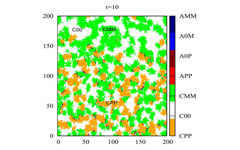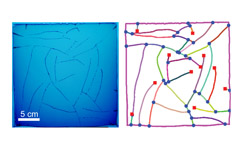Accueil
Studying emotions causing opinions to change (Vol. 44 No. 5)
 Example of evolution of agent opinions.
Example of evolution of agent opinions.
Physicists can use their tools to help understand how, in real life, opinions form and change by modelling the complex interactions between information and emotion. Social phenomena fascinate with their complexity, but are not easily understood. The author of the present article has developed a model to study the dynamic of ‘agents’ and their response to a given piece of information, depending on their emotional state. He shows that opinion dynamics differ depending on whether the agent is agitated or not.
The premise for this study was to consider that a given agent opinion about a particular issue is determined by both its information about the issue and its subsequent emotional response. The author assumes the possibility of the same information leading to different opinions when agents are agitated. This results in an individual opinion dynamics.
The author’s findings, relevant to a simplified social environment, are directly comparable with social observations. These include the stability of minority groups surrounded by enemies and the fact that so many elections have results close to the 50/50 ratio.
P. Sobkowicz, ‘Minority persistence in agent based model using information and emotional arousal as control variables’, Eur. Phys. J. B, (2013)
[Abstract]
When diffusion depends on chronology (Vol. 44 No. 5)
 Motorways are examples of nodes connected by edges studied as complex networks. (Photo Credit: Highways Agency)
Motorways are examples of nodes connected by edges studied as complex networks. (Photo Credit: Highways Agency)
The present work shows that the order of events taking place in complex networks may dramatically alter the way diffusion occurs in them. The Internet, motorways and other transport systems as well as many social and biological systems are composed of nodes connected by edges, and can be represented as networks.
Scientists studying diffusion over such networks over time have now identified the temporal characteristics that affect their diffusion pathways. In this paper, the authors show that one key factor that can dramatically change a diffusion process is the order in which events take place in complex networks.
They developed an analytical model to better understand the properties of time-dependent networks that either accelerate or slow down diffusion. Their study focused on different classes of popular models for diffusion, namely random walks and epidemic spread models, and found the way in which the temporal ordering of events matters. They expect these results to help in building more appropriate metrics to understand real-world complex network data.
R. Lambiotte, L. Tabourier and J.C. Delvenne, ‘Burstiness and spreading on temporal networks’, Eur. Phys. J. B (2013)
[Abstract]
A meta-diffraction-grating for visible light (Vol. 44 No. 5)
 Intensities diffracted into first diffraction order. Inset: SEM image of the planar meta-grating mimicking a bulk blazed grating profile.
Intensities diffracted into first diffraction order. Inset: SEM image of the planar meta-grating mimicking a bulk blazed grating profile.
Metamaterials — artificially engineered structures with building blocks smaller than the wavelength of light — have delivered a new way to design and make materials with exotic electromagnetic properties. The current challenge is to make these metamaterials into meta-devices that convert the promising research into practical applications. Nanotechnology has made it possible to fabricate ultrathin metamaterials – less than a 15th of the wavelength – shrinking conventional optical devices into planar form. In the coming years, research in metamaterials, plasmonics and nanofabrication will revolutionize device form and function throughout the electromagnetic spectrum.
This paper reports experimental demonstration of a planar ultrathin (50 nm) gold diffraction grating, mimicking the function of a bulk dielectric grating but tens of times thinner. It uses the resonant properties of individual sub-wavelength meta-atoms to change the phase of the light passing through it, in the same way as a blazed diffraction grating. It functions throughout the visible region of the spectrum (400 – 900 nm), with peak efficiency at 736 nm, and exhibits asymmetric diffraction, sending 25 times more light to the left than the right.
T. Roy, A.E. Nikolaenko and E.T.F. Rogers, ‘A meta-diffraction-grating for visible light’, J. Opt. 15, 085101 (2013)
[Abstract]
Topology of fluid drainage fracture networks (Vol. 44 No. 5)
 Drainage fractures in gelatine layer. Blue circles – nodes, red squares – dead ends.
Drainage fractures in gelatine layer. Blue circles – nodes, red squares – dead ends.
Fluid generation in rocks is a common phenomenon: generation of hydrocarbons (oil\gas) from source rocks during diagenesis, dehydration of sedimentary and metamorphic rocks during burial and partial melting of the Earth’s mantle. Fluid generation leads to local increase in fluid pressure. If the rate of fluid production is high compared to the rate at which fluids can escape by flow through the initial permeability, the fluid pressure increases and may cause fracturing and creation of new fluid transport pathways.
This paper presents the development of fracture networks in a simple quasi-2D system consisting of a confined layer of gelatine containing yeast that consumes sugar to produce CO2. The topological properties of the emerging fracture networks were found to be intermediate between the tree-like structure of river networks and the fragmentation cracking patterns observed in drying muds, domain splitting during rock weathering and fracturing of cooling basalts. The ratio of the number of dead ends to the amount of nodes is ~0.4, between the ratio for rivers (=1) and fragmentation crack patterns (=0). Understanding of fluid drainage network topology is crucial for uncovering the mechanisms which lead to its formation.
M. Kobchenko, A. Hafver, E. Jettestuen, O. Galland, F. Renard, P. Meakin, B. Jamtveit and D. K. Dysthe, ‘Drainage fracture networks in elastic solids with internal fluid generation’, EPL, 102, 66002 (2013)
[Abstract]







